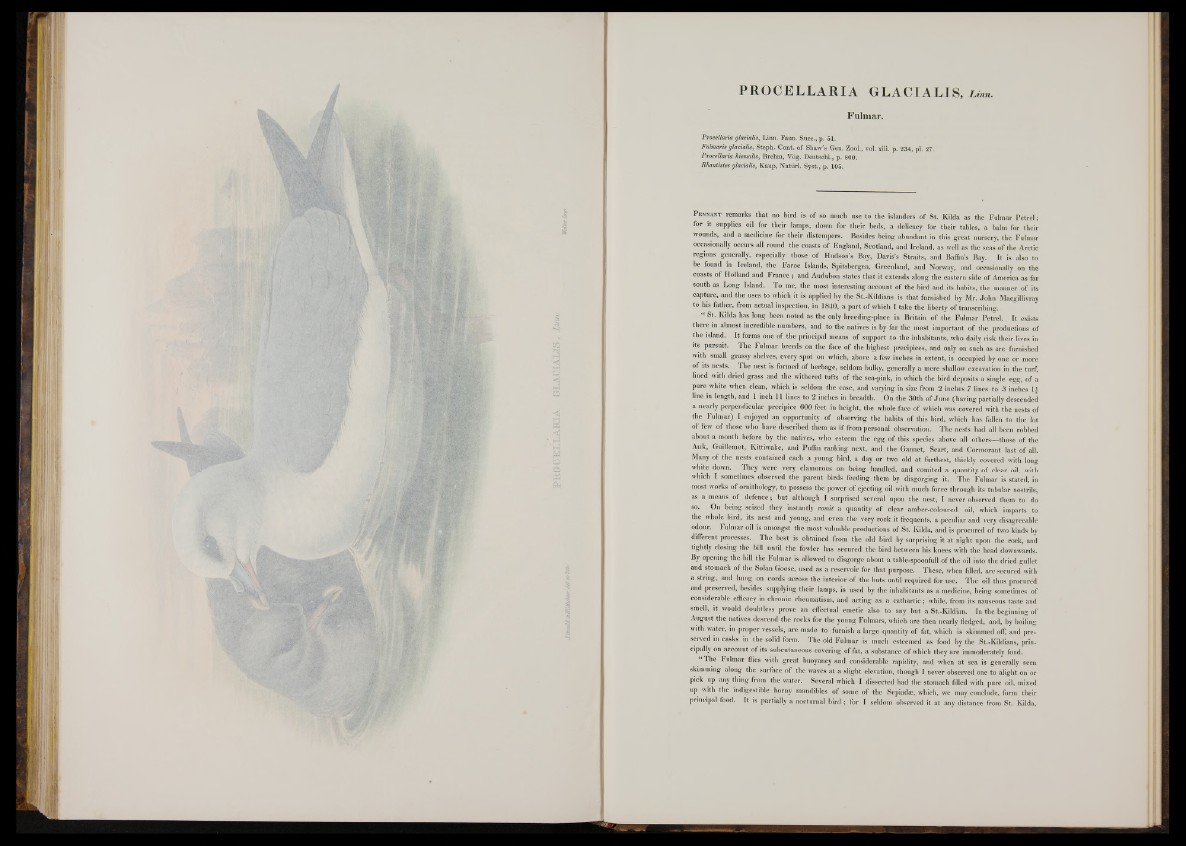
Fulmar.
Procellaria glacialis, Linn. Faun. Suec., p. 51.
Fulmaris glacialis, Steph. Cont. of Shaw’s Gen. Zool., vol. xiii. p. 234, pi. 27.
Procellaria hiemalis, Brehm, Vog. Deutschl., p. 800.
Rhantistes glacialis, Kaup, Naturi. Syst., p. 105.
P en n a n t remarks that no bird is of so much use to the islanders o f S t . Kilda as the Fulmar Petrel;
for it supplies oil for their lamps, down for their beds, a delicacy for their tables, a balm for their
wounds, and a medicine for their distempers. Besides being abundant in this great nursery, the Fulmar
occasionally occurs all round the coasts o f England, Scotland, and Ireland, as well as the seas of the Arctic
regions generally, especially those o f Hudson’s Bay, Davis’s Straits, and Baffin’s Bay. It is also to
be found in Iceland, the Faroe Islands, Spitsbergen, Greenland, and Norway, and occasionally on the
coasts of Holland and France ¡ and Audubon states that it extends along the eastern side of America as far
south as Long Island. To me, the most interesting account o f the bird and its habits, the manner o f its
capture, and the uses to which it is applied by the St.-Kildians is that furnished by Mr. John Macgillivray
to his father, from actual inspection, in 1840, a part o f which I take the liberty of transcribing.
“ St. Kilda has long been noted as the only breeding-place in Britain of the Fulmar Petrel. It exists
there in almost incredible numbers, and to the natives is by far the most important of the productions of
the island. It forms one of the principal means o f support to the inhabitants, who daily risk their lives in
its pursuit. The Fulmar breeds on the face o f the highest precipices, and only on such as are furnished
with small grassy shelves, every spot on which, above a few inches in extent, is occupied by one or more
o f its nests. The nest is formed o f herbage, seldom bulky, generally a mere shallow excavation in the turf,
lined with dried grass and the withered tufts o f the sea-pink, in which the bird deposits a single egg, o f a
pure white when clean, which is seldom the case, and varying in size from 2 inches 7 lines to 3 inches 14.
line in length, and 1 inch II lines to 2 inches in breadth. On the 30th o f June (having partially descended
a nearly perpendicular precipice 600 feet in height, the whole face of which was covered with the nests of
the Fulmar) I enjoyed an opportunity of observing the habits o f this bird, which has fallen to the lot
o f few o f those who have described them as if from personal observation. The nests had all been robbed
about a month before by the natives, who esteem the egg o f this species above all others—those o f the
Auk, Guillemot, Kittiwake, and Puffin ranking next, and the Gannet, Scart, and Cormorant last o f all.
Many of the nests contained each a young bird, a day or two old at furthest, thickly covered with long
white down. They were very clamorous on being handled, and vomited a quantity o f clear oil, with
which I sometimes observed the parent birds feeding them by disgorging it. The Fulmar is stated, in
most works of ornithology, to possess the power of ejecting oil with much force through its tubular nostrils,
as a means o f defence; but although I surprised several upon the nest, I never observed them to do
so. On being seized they instantly vomit a quantity o f clear amber-coloured oil, which imparts to
the whole bird, its nest and young, and even the very rock it frequents, a peculiar and very disagreeable
odour. Fulmar o iljs amongst the most valuable productions o f St. Kilda, and is procured of two kinds by
different processes. The best is obtained from the old bird by surprising it at night upon the rock, and
tightly closing the bill until the fowler has secured the bird between his knees with the head downwards.
By opening the bill the Fulmar is allowed to disgorge about a table-spoonfull o f the oil into the dried gullet
and stomach o f the Solan Goose, used as a reservoir for that purpose. These, when filled, are secured with
a string, and hung on cords across the interior o f the huts until required for use. The oil thus procured
and preserved, besides supplying their lamps, is used by the inhabitants as a medicine, being sometimes of
considerable efficacy in chrouic rheumatism, and acting as a cathartic; while, from its nauseous taste and
smell, it would doubtless prove an: effectual emetic also to any but a St.-Kildian. In the beginning of
August the natives descend the rocks for the young Fulmars, which are then nearly Hedged, and, by boiling
with water, in proper vessels, are made to furnish a large quantity of fat, which is skimmed off, and preserved
in casks in the solid form. The old Fulmar is much esteemed as food by the St.-Kildians, principally
on account o f its subcutaneous covering of fat, a substance o f which they are immoderately fond.
The Fulmar flies with great buoyancy and considerable rapidity, and when at sea is generally seen
skimming along the surface o f the waves at a slight elevation, though I never observed one to alight on or
pick up any thing from the water. Several which I dissected had the stomach filled with pure oil, mixed
up with the indigestible horny mandibles o f some of the Sepiadse, which, we may conclude, form their
principal food. It is partially a nocturnal bird ; for I seldom observed it at any distance from St. Kilda,